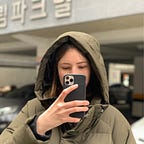05 | Micro UX: Choices
Group members: Damul Yang, Moxue Jia, Giada Han and Maria Shuttleworth
<<< For my previous project on Micro UX, click here.
Last week we successfully framed the project using a microscope, and the microscopic view of things. The successful framing of the topic lead to a coherent outcome in the mid-point review which we were very proud of. Now, we needed to expand upon what we had. We begun the week by thinking how we can develop the human interaction aspect of what we had created.
The microscope already encourages human interaction: you have to look through the lens, and focus what you see. We thought we could expand upon this by merging the microscope with our TouchDesigner visuals so that you can see them through the lens.
I wanted to see if this would work, so I used the video of last weeks TouchDesigner footage with my phone and iPad, to see which would show a clearer image under the microscope. Sadly, the phone only showed the individual LEDs on the screen, instead of the video. The iPad yeiled some results but the device was too big in comparison to the microscope to be used.
We moved on from this idea, with the four of us developing different storyboards showing different directions we could take the project in.
In my storyboard I considered making a fake microscope within which we could see both the real microscope image and the TouchDesigner output. These would take place in two compartments which you can choose between. You would be able to change the slide in the microscope through a hole in the side, after which the image on the TouchDesigner side would change to show what slide you had put in.
After sharing our ideas, we brainstormed on several sheets of paper, and came up with two possible outcomes. However, we could not decide between them so we took them to class for the weekly presentation for opinions from our classmates.
Idea number 1: Human impact on plants & the microclimate
The experience would start with the participant filling out a questionnaire which would determine whether you value plants or not — this was currently a very binary question, and would be developed. The outcome varies depending on their answer, however, in both scenarios they are guided to face a projection of cells under a microscope on a wall. A kinect that we set up would then pick up their movements and form, and layer their outline onto the projection. If the questionnaire determined they value plants, then they will be projected onto cells that a lively, bright and green. But if they choose differently, they would see themselves on a dead, unmoving and brown set of cells. With this effect we wanted the participant to realise that this is the result of their actions, and mindset.
Idea number 2: Symbiotic relationships
The second idea uses an Arduino with heat sensors that we attach to the plant, with a live TouchDesigner feed playing on the wall behind the plant. We would give participants a choice of two items of different temperatures: ice and a heat pack. We would also allow them to just use their hands. The ice and heat pack represent two different extreme temperatures, and the hand neutral. The participant would then choose an item / their hand to touch the plant with, and then depending on the temperature the live TouchDesigner output would change accordingly; neutral is healthy, hot and cold are dying. The idea here was to emphasise a symbiotic relationship between humans and plants, as we survive in similar climates to plants whereas neither a plant of a human can survive in either extreme.
Presentation.
This week the course experimented with a new way of giving and receiving feedback: feedback speed dating, where we got to present to four groups, and then they presented to us.
Feedback.
The class generally preferred the first idea, saying that it was more immersive than the second. However, although they preferred it they mentioned several areas in which it could improve, which I agree with. The questionnaire part needs to be developed so it can be more subtle, and the ending needs to be expanded providing more outcomes than just thriving and dying.
Finally, when we chatted to John and Al for the afternoon feedback, they complimented us saying it seems to be an aesthetic way of reinforcing a connection to the natural world. However, at the moment it is a little over-simple, and the link to the micro-climate, as well as CPG, is missing. We need to spend the next week thinking about where the experience will physically take place, and then through that we will be able to finalise certain aspects of it.
>>> For my next project on Micro UX, click here.
